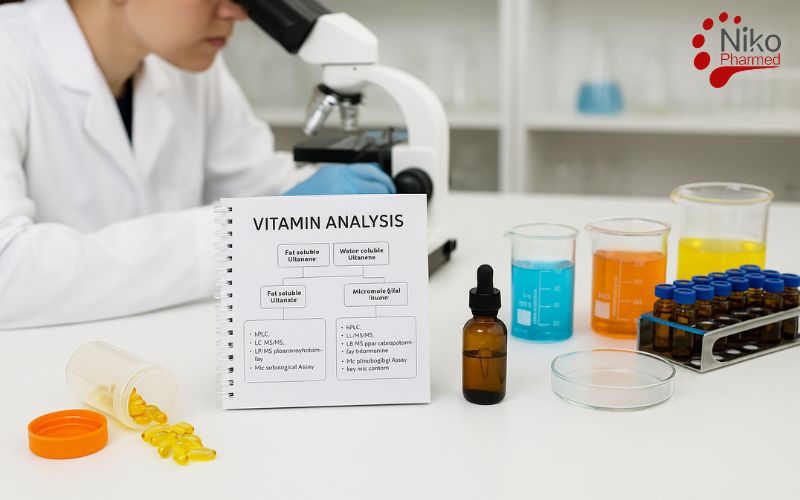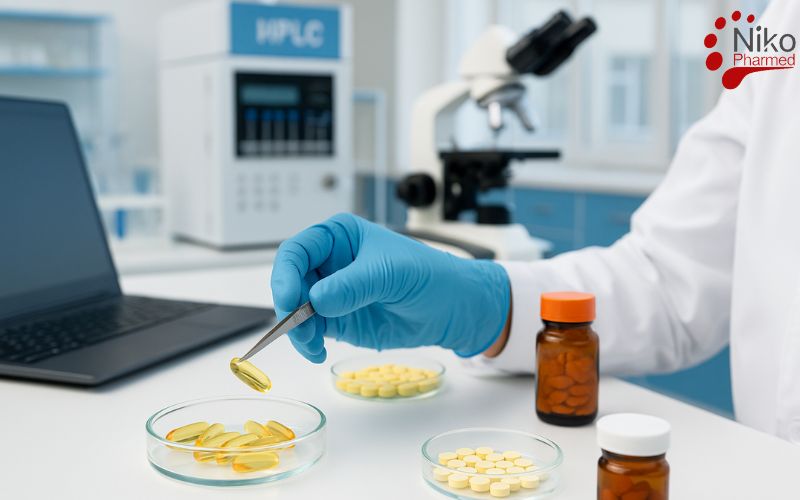What is Vitamin Analysis?
Vitamin analysis is the scientific process of quantitatively and qualitatively determining the concentration and composition of vitamins in supplements, foods, beverages, and pharmaceutical products to ensure quality, safety, and regulatory compliance.
Vitamins are broadly classified into fat-soluble (A, D, E, K) and water-soluble (B-complex, C) categories, each requiring specific analytical approaches due to differences in solubility, stability, and bioavailability.
By establishing precise vitamin profiles, manufacturers can validate nutritional claims, optimize formulation stability, comply with labeling standards, and meet pharmacopoeial or international regulatory requirements. This ensures that products deliver the intended health benefits while safeguarding consumer well-being. In nutritional and functional food projects, Vitamin Analysis is often combined with Total Polyphenol Content Assays (TPC) and Total Sugar Content Analysis to provide a complete profile of micronutrients and bioactive compounds for label claims and product positioning.
Vitamin Analysis Methods
The United States Pharmacopeia (USP) specifies analytical procedures for individual vitamins and multivitamin preparations, focusing on accuracy, precision, specificity, and reproducibility. Below are the principal methods recognized by the USP and harmonized with global standards such as the European Pharmacopoeia (Ph. Eur.), AOAC Official Methods, and Codex Alimentarius.
1. High-Performance Liquid Chromatography (HPLC)
HPLC separates vitamins based on polarity or molecular interactions with the stationary phase, allowing quantitative determination using UV-Vis or fluorescence detectors.
USP Application: Widely used for fat-soluble vitamins (A, D, E, K) and water-soluble vitamins (B-complex, C) in single- or multivitamin formulations. For example:
- USP <581> Vitamin A Assay (retinol and derivatives, reverse-phase C18, UV detection at ~325 nm)
- USP monographs for Vitamin D2/D3 (reverse-phase C18, UV at 265 nm)
Advantages: High resolution, suitability for complex matrices, ability to simultaneously quantify multiple vitamins.
Limitations: Requires careful sample preparation (e.g., saponification for fat-soluble vitamins) to avoid degradation.
2. Liquid Chromatography–Mass Spectrometry (LC-MS/MS)
Combines chromatographic separation with mass spectrometric detection for enhanced sensitivity, selectivity, and structural identification.
USP Application: Recognized for vitamins and their metabolites where high sensitivity is required (e.g., 25-hydroxyvitamin D in biological matrices).
Advantages: Extremely low detection limits, multi-analyte capability, structural confirmation.
Limitations: High operational cost and technical expertise requirements.
3. Ultraviolet-Visible Spectrophotometry (UV-Vis)
Measures the absorbance of a vitamin or its derivative at a specific wavelength, often after reaction with a color reagent.
USP Application:
- USP <401> Vitamin C Assay using 2,6-dichlorophenolindophenol (DCPIP) redox titration with spectrophotometric endpoint.
- Applied to certain B vitamins after derivatization.
Advantages: Simple, rapid, cost-effective.
Limitations: Less specific; prone to interference from matrix components.
In routine laboratory practice, these assays are performed using dedicated Ultraviolet–Visible Spectroscopic (UV-Vis absorption) platforms that are regularly qualified for vitamin testing.
4. Fluorometry
Quantifies intrinsic or induced fluorescence of certain vitamins (e.g., riboflavin) using a fluorometer.
USP Application:
Riboflavin determination after acid hydrolysis and oxidation to lumiflavin.
Advantages: High sensitivity, suitable for low-level detection.
Limitations: Limited applicability; not suitable for all vitamins without derivatization.
5. Gas Chromatography (GC)
Separates volatile derivatives of vitamins in a temperature-programmed capillary column, with detection via flame ionization (FID) or mass spectrometry (GC-MS).
USP Application: Fat-soluble vitamins that can be derivatized to volatile forms (e.g., tocopherol acetate analysis).
Advantages: High resolution for certain isomers, stable separation profiles.
Limitations: Not suitable for thermolabile vitamins without derivatization.
6. Microbiological Assays
Measures the growth response of a vitamin-dependent microorganism proportional to the vitamin concentration in the test sample.
USP Application:
- USP <141> Microbiological Assay for Vitamin B12 using Lactobacillus delbrueckii subsp. lactis.
- Also used for folic acid and biotin determination.
Advantages: Determines biologically active forms, useful for complex matrices.
Limitations: Time-consuming, requires stringent growth control conditions.
For liquid multivitamin syrups, infant formulas and clinical nutrition products, microbiological vitamin assays are frequently integrated with MIC/MBC Testing or Antibacterial Testing so that both nutritional potency and microbiological safety can be assessed within a single study program
7. Enzyme-Linked Immunosorbent Assay (ELISA)
Uses antigen-antibody binding to selectively detect vitamins or metabolites.
USP Relevance: While not a primary USP method for vitamin assay, it is recognized for clinical and research purposes (e.g., vitamin D metabolite detection).
Advantages: High throughput, minimal sample preparation.
Limitations: Potential cross-reactivity; usually requires confirmation by chromatographic methods for regulatory use.
Regulatory and Validation Requirements
All vitamin analysis methods prescribed in the USP are validated according to ICH Q2(R1) guidelines, ensuring:
Specificity: No interference from excipients or matrix components.
Accuracy & Precision: Recovery studies and repeatability testing.
Linearity & Range: Calibration over the expected concentration range.
Detection & Quantitation Limits: Ensuring sensitivity meets regulatory limits.
Robustness: Method performance under small procedural variations.
Comparative Matrix of Vitamin Analysis Methods
| Vitamin / Group | USP Reference / Monograph | Analytical Technique | Key Performance Parameters |
|---|---|---|---|
| Vitamin A (Retinol, Retinyl Acetate/Palmitate) | USP <581> “Vitamin A Assay” | HPLC (Reversed-phase C18, UV @ ~325 nm) | Saponification to release esters; protection from light; detection limit ~0.1 µg/mL; high specificity for isomers. |
| Vitamin D2 & D3 (Ergocalciferol, Cholecalciferol) | USP “Vitamin D Capsules/Tablets” | HPLC (Reversed-phase, UV @ 265 nm) | Saponification + extraction; prevent photodegradation; LOD ~0.05 µg/mL; accurate for fortified foods and pharmaceuticals. |
| Vitamin E (Tocopherols & Tocotrienols) | USP “Vitamin E Capsules” | HPLC (Normal-phase or RP, UV @ 292 nm) | Extraction with organic solvents; LOD ~0.2 µg/mL; protects against oxidation with inert gas. |
| Vitamin K1 & K2 (Phylloquinone, Menaquinones) | USP “Phytonadione” | HPLC (Fluorescence detection after post-column reduction) | Highly sensitive for low-level detection; requires reduction step; LOD <0.01 µg/mL. |
| Vitamin C (Ascorbic Acid) | USP <401> “Vitamin C Assay” | UV-Vis spectrophotometry (DCPIP redox titration) or HPLC (UV @ 245 nm) | Minimal light/oxygen exposure; rapid assay; LOD ~1 µg/mL (HPLC). |
| Vitamin B1 (Thiamine) | USP “Thiamine Hydrochloride” | Fluorometry after oxidative derivatization to thiochrome | Requires oxidation step; LOD <0.05 µg/mL; sensitive for fortified foods. |
| Vitamin B2 (Riboflavin) | USP “Riboflavin” | Fluorometry (Excitation @ 450 nm, Emission @ 520 nm) | Acid hydrolysis to release bound riboflavin; LOD <0.01 µg/mL. |
| Vitamin B3 (Niacin, Niacinamide) | USP “Niacin” / “Niacinamide” | HPLC (UV @ 260 nm) | Requires acid hydrolysis for food samples; LOD ~0.1 µg/mL. |
| Vitamin B5 (Pantothenic Acid) | USP “Calcium Pantothenate” | Microbiological assay (Lactobacillus plantarum) or HPLC | Biologically active measurement; LOD ~0.5 µg/mL (HPLC). |
| Vitamin B6 (Pyridoxine, Pyridoxal, Pyridoxamine) | USP “Pyridoxine Hydrochloride” | HPLC (UV @ 290 nm) | Requires acidic extraction; LOD ~0.05 µg/mL. |
| Vitamin B7 (Biotin) | USP “Biotin” | Microbiological assay (Lactobacillus plantarum) or HPLC-MS | Biologically active quantification; LOD <0.1 µg/mL. |
| Vitamin B9 (Folic Acid) | USP “Folic Acid” | Microbiological assay (Lactobacillus rhamnosus) or HPLC | Sensitive to oxidative loss; LOD ~0.05 µg/mL (HPLC). |
| Vitamin B12 (Cobalamins) | USP <141> “Microbiological Assay for Vitamin B12” | Microbiological assay (Lactobacillus delbrueckii subsp. lactis) or HPLC-MS/MS | Detects active forms; LOD <0.01 µg/mL; protects from light. |
Nikopharmad Vitamin Analysis Laboratory
Accreditation and Global Recognition
At Nikopharmad, our Vitamin Analysis services are supported by ISO/IEC 17025 certification and ILAC accreditation, ensuring full compliance with internationally recognized standards of analytical quality and technical competence. These credentials confirm that our vitamin testing results meet the highest global regulatory requirements, accepted by USP, European Pharmacopoeia (Ph. Eur.), AOAC International, Codex Alimentarius, and health authorities worldwide.
Technical Excellence and Validated Infrastructure
Our state-of-the-art analytical laboratory is equipped with advanced instrumentation, including high-performance liquid chromatography (HPLC), ultra-performance liquid chromatography (UPLC), LC-MS/MS, UV-Vis spectrophotometers, and dedicated systems for microbiological assays. We adhere to validated pharmacopeial methodologies. Strict environmental controls, calibrated instruments, and standardized preparation protocols safeguard sample integrity from collection to final reporting.
Regulatory-Ready Reporting and Timely Results
In the competitive regulatory landscape, rapid and reliable results are critical. Nikopharmad delivers vitamin testing data with full method validation records, traceable raw data, and statistically analyzed results suitable for submission to the FDA, EMA, and other global agencies. Our streamlined workflow ensures fast turnaround times without compromising accuracy or compliance, supporting product launches, nutritional labeling, and quality control programs.
Confidentiality and Data Integrity
We prioritize client confidentiality and data security. All vitamin analysis activities are conducted under strict non-disclosure agreements and supported by 21 CFR Part 11-compliant electronic data systems. We maintain a complete audit trail for every analysis, ensuring the integrity and traceability of all results. Sensitive information and proprietary formulations are handled with the utmost ethical and professional care.
Competitive Pricing with Uncompromised Quality
We offer competitive, transparent pricing for vitamin testing services, accommodating the needs of startups, SMEs, and multinational corporations. Our cost-effective analytical solutions help accelerate regulatory approval timelines while ensuring compliance with international standards and uncompromised scientific rigor.
To request testing or a complimentary consultation contact Nikopharmad
Partner with Nikopharmad for Expert Vitamin Analysis
By partnering with Nikopharmad, you gain access to a globally accredited laboratory committed to scientific excellence, regulatory compliance, and confidentiality. Whether verifying label claims, ensuring stability during shelf-life studies, or meeting strict pharmacopeial specifications, our vitamin analysis expertise ensures accurate, reliable, and internationally recognized results—helping you achieve faster and compliant market access.



